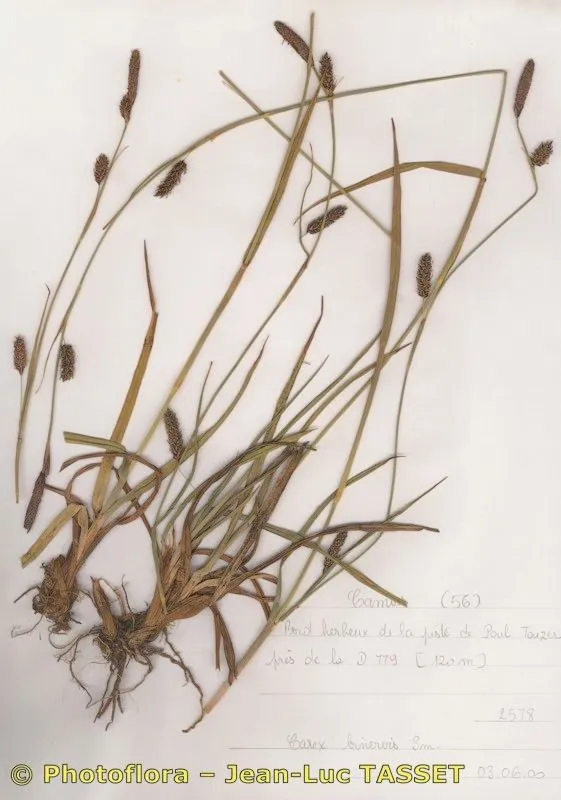
Author: Sm.
Bibliography: Trans. Linn. Soc. London 5: 268 (1800)
Year: 1800
Status: accepted
Rank: species
Genus: Carex
Vegetable: False
Observations: W. & N. Europe
Green-ribbed Sedge (Carex binervis)
The Green-ribbed Sedge, scientifically known as Carex binervis, is a prominent species within the family Cyperaceae. First described by Sm. in the Transactions of the Linnean Society of London in the year 1800, this plant has since been an important subject of study due to its distinctive features and ecological significance.
Description and Characteristics
Green-ribbed Sedge is noted for its tufted growth habit, with stems that generally rise erect and can reach notable heights. The foliage is distinctive, featuring leaves that are characterized by their green ribs—hence the common name. The plant is adapted to thrive in a variety of moist habitats, where it often forms dense clumps or tussocks, contributing significantly to the ground cover and stabilizing the soil.
Habitat and Distribution
The primary geographic range of Carex binervis encompasses Western and Northern Europe. This sedge favors damp, acidic environments such as bogs, heathlands, and wet meadows. Its resilience to varying moisture levels and its ability to grow in both light and shade allow it to colonize a range of ecological niches within these regions.
Ecological Importance
Green-ribbed Sedge plays a crucial role in its native habitats. Its presence supports a diverse array of wildlife, providing food and shelter to numerous invertebrates and small mammals. Additionally, the dense root systems of Carex binervis help in soil stabilization and the prevention of erosion, which is particularly valuable in wetland and riparian zones.
Uses and Applications
While Carex binervis is primarily valued for its ecological contributions, it is also of interest for certain traditional and practical uses. In some regions, it has been historically utilized for thatching and basketry. Modern uses may include incorporation into natural landscaping projects aimed at enhancing biodiversity and reviving natural wetland environments.
Conservation and Management
The conservation of Green-ribbed Sedge is imperative, given its role in sensitive ecosystems. Efforts to protect natural populations include habitat restoration, prevention of overgrazing by livestock, and the control of invasive species that threaten its growth. Monitoring the health of Carex binervis populations can serve as an indicator of the overall health of the ecosystems they inhabit.
In conclusion, Carex binervis, or Green-ribbed Sedge, remains a vital species within its native European habitats. Its intricate role in both the ecological framework and traditional human practices underscores the importance of continued research and conservation efforts.
Deu: zweinervige segge
Swe: hedstarr
Nob: heistarr
Nno: heistorr
Eng: green-ribbed sedge, moor sedge
Nld: tweenervige zegge
Cym: hesgen ddeulasnod
En: Green-ribbed Sedge, Moor Sedge
Nl: Tweenervige zegge
Fi: Nummisara
Fr: Laiche à deux nervures, Laîche à deux nervures
De: Zweinervige Segge
Nb: Heistarr
Nn: Heistorr
Fa: کارکس بینرویس
Ru: Осока двухжильчатая
Sv: Hedstarr
Cy: Hesgen ddeulasnod
: Green-ribbed sedge
Taken Jul 15, 2012 by Photoflora – Jean-Luc TASSET (©)
Taken Jul 15, 2012 by Photoflora – Jean-Luc TASSET (©)
Taken Jun 3, 2019 by Tela Botanica − Florent Beck (cc-by-sa)
Taken Jun 3, 2019 by Tela Botanica − Florent Beck (cc-by-sa)
Taken Jun 3, 2019 by Tela Botanica − Florent Beck (cc-by-sa)
Taken Jul 15, 2006 by Photoflora – Benoit BOCK (©)
Taken Jul 15, 2016 by Photoflora – Benoit BOCK (©)
Taken Jan 1, 1970 by Photoflora – L’Abbé COSTE (©)
Taken Jul 15, 2016 by Photoflora – Benoit BOCK (©)
Taken Jun 11, 1852 by Tela Botanica − Herbier PONTARLIER-MARICHAL (cc-by-sa)
Taken Jun 3, 2019 by Tela Botanica − Florent Beck (cc-by-sa)
Taken Jun 3, 2019 by Tela Botanica − Florent Beck (cc-by-sa)
Taken Jun 3, 2019 by Tela Botanica − Florent Beck (cc-by-sa)
Taken Jun 3, 2019 by Tela Botanica − Florent Beck (cc-by-sa)
Taken Jun 26, 2016 by Tela Botanica − Stephen LEROY (cc-by-sa)
Taken Aug 15, 2000 by Photoflora – Jean-Luc TASSET (©)
Taken Jun 3, 2019 by Tela Botanica − Florent Beck (cc-by-sa)
Taken Jun 3, 2019 by Tela Botanica − Florent Beck (cc-by-sa)
Taken Jun 3, 2019 by Tela Botanica − Florent Beck (cc-by-sa)
Taken Jun 3, 2019 by Tela Botanica − Florent Beck (cc-by-sa)
Taken Jun 3, 2019 by Tela Botanica − Florent Beck (cc-by-sa)
Taken Jun 3, 2019 by Tela Botanica − Florent Beck (cc-by-sa)
Taken Jun 3, 2019 by Tela Botanica − Florent Beck (cc-by-sa)
Ph maximum: 4.0
Ph minimum: 3.0
Light: 7
Atmospheric humidity: 6
Soil nutriments: 1
Family: Myrtaceae Author: (F.Muell.) K.D.Hill & L.A.S.Johnson Bibliography: Telopea 6: 402 (1995) Year: 1995 Status:…
Family: Rubiaceae Author: Pierre ex A.Froehner Bibliography: Notizbl. Bot. Gart. Berlin-Dahlem 1: 237 (1897) Year:…
Family: Sapindaceae Author: Koidz. Bibliography: J. Coll. Sci. Imp. Univ. Tokyo 32(1): 38 (1911) Year:…
Family: Asteraceae Author: A.Gray Bibliography: Pacif. Railr. Rep.: 107 (1857) Year: 1857 Status: accepted Rank:…
Family: Fabaceae Author: Medik. Bibliography: Vorles. Churpfälz. Phys.-Ökon. Ges. 2: 398 (1787) Year: 1787 Status:…
Family: Aspleniaceae Author: (Cav.) Alston Bibliography: Bull. Misc. Inform. Kew 1932: 309 (1932) Year: 1932…